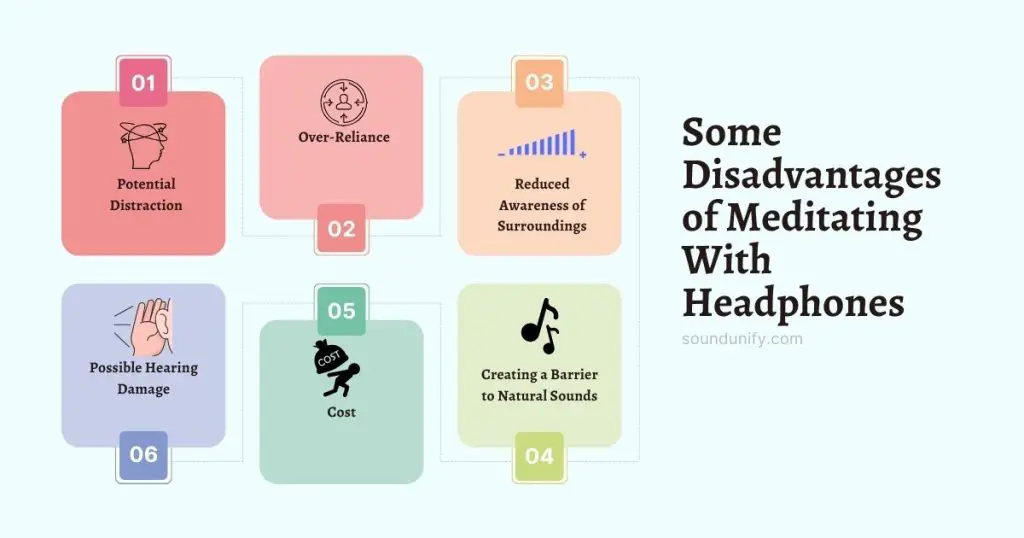Yes, you can meditate with headphones on. They're especially great for guided meditations and blocking out distractions. But let's dive deeper, shall we?
I’ve discovered that slipping on a pair of headphones can transform your meditation experience. Picture this: it’s just you and your inner world, no external chaos, no sudden noises pulling you back to reality. That’s the magic headphones bring to your meditation practice.
But here’s the catch – not all meditations and not all headphones are created equal. I’ve navigated through the maze of choices, from noise-canceling giants to the softest binaural beats. And, trust me, the differences are stark.
So, if you’re wondering whether to reach for those headphones during your next meditation session or if you’re curious about the impact they could have, stay with me.
I’m about to unravel my journey and insights, hoping to guide you toward a more focused and profound meditative practice. Let’s explore together how this simple tool can deeply influence the quality of your mindfulness journey.
8 Benefits of Meditating with Headphones
Meditating with headphones offers unique benefits that can enhance the overall experience. Here’s an in-depth look at these advantages:
1. Blocks Environmental Noise

Creating a serene environment is crucial for effective meditation. However, in our daily lives, it’s common to encounter a range of distracting noises, from traffic sounds to household activity.
This is where using headphones becomes a game changer. They serve as a personal barrier, shielding you from these external distractions. This isolation is particularly beneficial for those living in urban environments or with busy households.
By blocking out environmental noise, headphones help maintain the tranquility and focus essential for deep meditation. This makes them an invaluable tool for both beginners and seasoned practitioners.
- Noise Isolation: Headphones, especially noise-canceling models, actively reduce ambient sounds.
- Improved Focus: With fewer distractions, it’s easier to concentrate on meditation.
- Accessibility: Makes meditation possible in various environments, not just quiet ones.
- Consistency: Helps maintain a consistent practice, regardless of your surroundings.
- Enhanced Experience: By creating a noise-free zone, headphones can make meditation more immersive and compelling.
| Feature | Benefit |
|---|---|
| Active Noise-Cancellation | Blocks external sounds, like traffic and conversation |
| Sound Isolation | Creates a personal, quiet space for meditation |
| Versatility | Enables meditation in diverse environments |
| Consistent Audio Experience | Provides a stable, distraction-free environment |
| Enhanced Concentration | Aids in maintaining focus during meditation |
2. Enhances Guided Meditations

Guided meditations, where a narrator leads the session, are a popular way for many to practice meditation, especially for beginners. The use of headphones can significantly enhance this experience.
High-quality headphones deliver clear, crisp sound, making every instruction and subtle background music heard distinctly. This clarity is crucial for following the guided session accurately and gaining the full benefit of the meditation.
Moreover, headphones help create an immersive experience. They make it easier for the practitioner to visualize and engage with the guided imagery. This can lead to a deeper state of relaxation and mindfulness, as the external world is effectively tuned out, and the focus is solely on the guidance provided.
For those who meditate in noisier environments, headphones can distinguish between a distracted, ineffective session and a deeply fulfilling one.
3. Ensures Binaural Beats Are Effective

Binaural beats are a form of soundwave therapy used in certain types of meditation, where slightly different sound frequencies are played in each ear.
Based on the mathematical difference between the two frequencies, the brain perceives a third tone. That can help induce relaxation, focus, or sleep. For binaural beats to be effective, each ear must hear only its designated frequency without overlap.
This is where headphones play a critical role. They ensure the correct frequency is isolated in each ear, allowing the brain to process the binaural beat as intended.
Without headphones, the distinct frequencies may blend in the air before reaching the ears, significantly reducing the effectiveness of the binaural beats.
- Isolation of Frequencies: Each ear receives the intended frequency without interference.
- Accurate Perception: Ensures the brain perceives the correct binaural beat.
- Enhanced Effectiveness: Increases the potential benefits of meditation with binaural beats.
- Versatility in Use: Allows for practical use in various environments.
| Aspect of Binaural Beats | Role of Headphones |
|---|---|
| Frequency Delivery | Delivers specific frequencies to each ear |
| Beat Perception | Ensures accurate perception of binaural beats |
| Meditation Efficacy | Enhances the overall effectiveness of the meditation |
| Environmental Versatility | Facilitates use in diverse settings |
4. Improves Focus and Concentration

Meditation is fundamentally about cultivating focus and concentration. But achieving this can be challenging, particularly in environments filled with distractions. Headphones play a pivotal role in enhancing this aspect of meditation.
By providing an auditory sanctuary, they help to minimize distractions that can scatter our thoughts and interrupt the flow of concentration. This is especially beneficial for practices like mindfulness or concentration meditation, where continuous focus is critical.
The sound quality of headphones also contributes, as clear and consistent audio can assist in keeping the mind engaged and centered on the meditation.
This can make the difference between a frustrating and fruitful session for beginners, as it helps train the mind to remain focused amidst potential distractions.
| Aspect of Concentration | Role of Headphones |
|---|---|
| Minimizing Distractions | Creates a distraction-free auditory environment |
| Enhancing Audio Quality | Provides clear, consistent sound for focus |
| Supporting Mindfulness | Aids in maintaining continuous concentration |
| Training Focus | It helps beginners develop better concentration skills |
| Adaptability | Facilitates focused meditation in various settings |
5. Increases Relaxation

The primary goal of many meditation practices is to induce a state of deep relaxation, both mentally and physically. Headphones can significantly aid in this process.
By isolating the listener from external noise and distractions, headphones create a peaceful auditory environment conducive to relaxation. This can be particularly soothing for individuals who live in noisy environments or have hectic lifestyles.
The immersive experience of headphones allows for a more profound connection with the meditative process, encouraging the body and mind to release tension and stress more effectively.
Furthermore, when combined with relaxing meditation tracks or natural sounds, headphones can enhance the overall calming effect, making it easier to reach a relaxed state.
6. Promotes Positive Moods
Meditation is often used to elevate mood and foster a sense of well-being. Headphones can significantly enhance this aspect of the practice.
- Enhanced Audio Experience: Delivers high-quality sound, making uplifting tracks more effective.
- Emotional Engagement: Creates an intimate space, allowing for a deeper emotional connection with the meditation.
- Isolation from Negativity: Shields from external, potentially mood-disrupting noises.
- Versatility in Mood Enhancement: Useful for various meditations to improve mood.
The immersive nature of headphones helps create a focused and intimate setting, which can be particularly beneficial for meditations to elevate mood.
The quality of sound and the seclusion provided help in engaging more deeply with the meditative content. Music, positive words, and sounds that help you feel better can make a big difference.
They can make you feel better and keep you from feeling sad or depressed. People who want to use meditation to help them relax or feel better can use headphones to make their practice more effective.
7. Reduces Anxiety

Meditation is widely recognized for its ability to reduce anxiety, and the use of headphones can significantly amplify this benefit. The immersive experience provided by headphones helps to create a sense of isolation from the external world.
It allows individuals to dive deeper into a state of relaxation and mindfulness. This isolation is particularly effective in reducing the sensory overload that often contributes to anxiety.
The mind is distracted from upsetting thoughts and problems by focusing on the sounds in the headphones. These can be calming music, guided meditations, or concentrating on breathing.
This shift in focus is a crucial mechanism through which meditation reduces anxiety. Headphones enhance this process by providing a controlled, consistent auditory environment. This can be particularly helpful for individuals who struggle with anxiety in noisy or chaotic surroundings.
- Sensory Isolation: Headphones provide a barrier to overstimulating environments.
- Consistent Auditory Environment: Offers a controlled setting conducive to relaxation.
- Focus on Calming Sounds: Aids in shifting attention away from anxious thoughts.
- Enhanced Guided Meditation: Allows more explicit engagement with anxiety-reducing instructions.
8. Versatility for Lifestyle
The adaptability of headphones to various lifestyles is a significant advantage for regular meditators. Whether in a bustling city, traveling, or just taking a break at work, headphones allow you to create a meditative space wherever you are. This versatility means that meditation is not confined to a specific location or time; it can be seamlessly integrated into any routine.
In particular, Bluetooth headphones offer the convenience of meditating without the hassle of cords, further enhancing their adaptability to different activities, like walking or light yoga. This flexibility is essential in today’s fast-paced world, where finding time and space for meditation can be challenging.
With headphones, meditation becomes a portable practice, adaptable to the demands and dynamics of modern living.
| Lifestyle Aspect | Role of Headphones |
|---|---|
| Urban Living | Allows meditation amidst city noise |
| Travel | Facilitates meditation in transit |
| Work Environment | It provides a quick, meditative escape |
| Outdoor Activities | Enhances meditation in natural settings |
| Flexibility in Routine | It makes meditation adaptable to any schedule |
The use of headphones in meditation not only enhances the practice itself but also expands its accessibility and convenience, making it a versatile tool adaptable to various lifestyles and environments.
Some Disadvantages of Meditating With Headphones

Meditating with headphones, while beneficial in many ways, also comes with certain disadvantages that are important to consider:
- Potential Distraction: For some, headphones can become a distraction rather than an aid. The sensation of wearing them, especially for extended periods, can be uncomfortable or distracting, drawing attention away from the meditation itself.
- Over-Reliance: There’s a risk of overly relying on headphones for meditation. This reliance can make it challenging to meditate effectively without them, limiting flexibility and adaptability in various environments.
- Reduced Awareness of Surroundings: Using headphones, especially noise-canceling ones, can significantly reduce awareness of your surroundings. This might not be suitable in specific environments where staying alert is essential, like in public spaces.
- Possible Hearing Damage: Listening to sounds or music at high volumes over prolonged periods can lead to hearing damage. Maintaining a safe volume level is crucial to prevent potential harm to your hearing.
- Cost: High-quality, noise-canceling headphones can be expensive. This cost may not be justifiable for everyone, especially those new to meditation and unsure about their long-term commitment to the practice.
- Creating a Barrier to Natural Sounds: Headphones can isolate you from natural environmental sounds beneficial in meditation, such as bird songs or wind. Some find these natural sounds more conducive to relaxation and mindfulness than artificial audio tracks.
It’s essential to weigh these disadvantages against the benefits when deciding whether to use headphones for meditation. The choice can vary greatly depending on personal preferences, the type of meditation being practiced, and the individual’s specific circumstances.
What sounds suitable for meditation?
When it comes to choosing sounds for meditation, it depends on what resonates with you and helps you deepen your practice. Here are some popular options that you might find beneficial:
- Nature Sounds: The sounds of nature, like flowing water, gentle rain, rustling leaves, or bird songs, can be incredibly soothing. They have a way of connecting you with the natural world, which can be grounding and calming.
- Binaural Beats: These are great if you want something more technical. Binaural beats involve playing two slightly different frequencies in each ear. The brain perceives a third tone, which can help induce relaxation or focus. Just remember, you’ll need headphones for these to be effective.
- Guided Meditations: If you’re new to meditation or prefer a more structured approach, guided meditations can be helpful. A soothing voice can lead you through relaxation techniques or mindfulness exercises, which can be particularly useful if your mind tends to wander.
- Instrumental Music: Soft, instrumental music without lyrics can be a great choice. Think gentle piano, slow strings, or even ambient electronic music. The key is finding something calming and not too stimulating or distracting.
- Tibetan Singing Bowls: The resonant sound of Tibetan singing bowls is used in some meditation practices. These sounds are believed to help induce a state of deep meditation and relaxation.
- Silence: Sometimes, the best sound for meditation is no sound. Sitting in silence can be incredibly powerful if you’re comfortable with it. It allows you to turn inward and become more aware of your thoughts and bodily sensations.
- Chants or Mantras: Reciting or listening to chants can be meditative. The repetitive nature of these sounds can help focus the mind and bring about a sense of inner peace.
The key is experimenting with different sounds and seeing what works best for you. What’s soothing and meditative for one person might be distracting for another. Also, be mindful of the volume; the sound should be gentle and non-invasive, allowing you to relax and focus inward.
6 Best Types of Meditations With Headphones
Using headphones for meditation can enhance the experience in several ways. Here are six of the best types of meditations to practice with headphones:
1. Mindfulness Meditation
Mindfulness meditation focuses on being intensely aware of what you’re sensing and feeling in the moment, without interpretation or judgment. It involves breathing methods, guided imagery, and other practices to relax the body and mind and help reduce stress. Here’s how you can practice it:
- Find a Quiet Spot: Choose a comfortable place where you won’t be disturbed.
- Set a Time Limit: Especially if you’re a beginner, start with short sessions, like 5-10 minutes.
- Focus on Your Breath: Pay attention to the sensation of your breath as you inhale and exhale.
- Notice When Your Mind Wanders: Your attention will leave the breath from time to time. When you notice this, return your focus to your breathing.
- Be Kind to Your Wandering Mind: Don’t judge yourself or obsess over the content of the thoughts you find yourself lost in. Just come back to your breathing.
Mindfulness meditation is about returning your attention again and again to the present moment. It’s a way to train the mind to be more aware, reducing stress and improving concentration and emotional well-being.
2. Nature Sound Meditation
Nature sound meditation involves listening to the calming sounds of the natural world, which can include the sound of water, wind, birds, or rustling leaves. These sounds can be incredibly relaxing and often enhance the meditation experience. To practice nature sound meditation:
- Choose Your Sounds: Decide if you want to meditate on the sound of waves, forest sounds, rain, or another natural setting. You can find many recordings online or apps dedicated to nature sounds.
- Find a Comfortable Position: Sit or lie in a comfortable position, in a place where you won’t be disturbed.
- Use Headphones: For a more immersive experience, listen to nature sounds. This can help block out any background noise and allow you to focus on the meditation entirely.
- Focus on the Sounds: Close your eyes and focus on the sounds. Notice the different layers of the soundscape and how they make you feel.
- Let Your Mind Wander: Unlike mindfulness meditation, with nature-sound meditation, letting your mind wander a bit is okay. The goal is to let the natural sounds guide your thoughts and feelings, potentially leading to a place of deep relaxation and peace.
Nature sound meditation is a beautiful way to connect with the natural world, even if you’re indoors. It can benefit those who find silence overwhelming or too intense for meditation.
3. Binaural Beats Meditation
Binaural Beats Meditation is a unique form of auditory-based meditation that uses sound to influence brainwave patterns, promoting mental states such as relaxation, focus, or sleep.
Binaural beats play two different frequencies in each ear. The brain perceives a third, illusionary tone—a binaural beat—the mathematical difference between the two frequencies. This can influence the brain’s state, with different frequency combinations aiming to induce relaxation, improved focus, or even sleep.
How to Practice:
- Choose Your Binaural Beat Track: Depending on your goal (e.g., relaxation, focus), select an appropriate binaural beats track.
- Use Headphones: This is crucial as binaural beats require each ear to receive a different frequency to create the desired effect.
- Find a Comfortable Place: Sit or lie in a comfortable, quiet spot where you won’t be disturbed.
- Set a Duration: Start with shorter sessions (10-15 minutes) and gradually increase as you get more comfortable with the practice.
- Close Your Eyes and Relax: Focus on the sound and let it guide your brain into a different state of consciousness.
- Observe Your Thoughts: Let your thoughts come and go, focusing back on the sound whenever your mind wanders.
4. Guided Meditation
Guided Meditation is when a narrator leads you through a meditation session. This can include instructions on breathing, visualization, body scans, or mindfulness techniques. It’s particularly beneficial for beginners or those struggling to focus during meditation. Here’s how to do it:
How to Practice:
- Select a Guided Meditation: Choose a session that suits your needs, whether for relaxation, stress relief, or mindfulness.
- Use Headphones: This helps minimize external distractions and allows you to focus more deeply on the guidance.
- Find a Comfortable Position: Sit or lie where you feel comfortable and won’t be disturbed.
- Follow the Instructions: Listen to the guide’s voice and follow their instructions. This may involve focusing on your breath, visualizing an image, or noticing sensations in your body.
- Allow Yourself to Be Led: Let the guide’s voice anchor you in the present moment, helping you to focus and relax.
- Gently Return When Distracted: If your mind wanders, gently bring your attention to the guide’s voice.
Binaural Beats and Guided Meditations are practical tools for enhancing the meditation experience, offering unique ways to focus the mind and achieve various states of consciousness. Whether you’re seeking relaxation, mental clarity, or a moment of peace, these practices can be highly beneficial.
5. Mantra Meditation
Mantra Meditation is a practice that involves the repetition of a specific sound, word, or phrase, known as a mantra. This form of meditation is rooted in various spiritual traditions but is widely used for its calming and focusing benefits.
The repetitive nature of chanting a mantra helps focus the mind. It can be a sound like “Om,” a word, or a series of talks. The mantra is repeated silently or aloud and serves as a focal point to draw your attention away from random thoughts.
How to Practice:
- Select a Mantra: Choose a mantra that resonates with you. It could be a traditional Sanskrit mantra, a word, or a phrase in any language.
- Find a Comfortable Position: Sit comfortably in a quiet place where you won’t be disturbed.
- Decide on the Repetition Method: You can repeat the mantra silently, whisper it, or chant it aloud.
- Set a Time Limit: Start with short sessions (5-10 minutes) and gradually increase the duration as you become more comfortable.
- Begin Chanting: Focus on the sound or vibration of the mantra, letting it fill your consciousness.
- Gently Refocus When Distracted: If your mind wanders, gently bring your focus back to the mantra.
6. Sound Bath Meditation
Sound Bath Meditation is an immersive auditory experience where you are ‘bathed’ in the sounds of various instruments, such as singing bowls, gongs, or tuning forks. It’s known for its ability to facilitate deep relaxation and stress relief.
How It Works: The sound vibrations produced by these instruments are heard and can be felt physically, offering a unique sensory experience. These vibrations can help calm the mind and body, leading to a meditative state.
How to Practice:
- Find a Sound Bath Session: You can attend a live sound bath event or find recorded sessions online.
- Use Headphones for Recorded Sessions: If you’re listening to a recording, use headphones for a more immersive experience.
- Create a Comfortable Space: Ensure you’re comfortable in a quiet and relaxing environment.
- Close Your Eyes and Relax: Fully immerse in the sounds and vibrations.
- Focus on the Sensations: Pay attention to how the sound waves feel in your body and affect your mind and emotions.
- Let Go of Expectations: Enter the experience without specific expectations and allow the sound to guide your inner journey.
Mantra and Sound Bath Meditations are powerful tools for achieving mental clarity and emotional balance. They offer different paths to the same destination: peaceful awareness and relaxation.
Whether you are drawn to the rhythmic repetition of a mantra or the resonant frequencies of a sound bath, these practices can provide a profound sense of calm and connectedness.
FAQs
Should I Meditate With Headphones On?
Yes, you can meditate with headphones on. They are handy for guided meditations, binaural beats meditation, or blocking out external noise for better focus.
Can I Hear Music with Earphones While Meditating?
Yes, you can listen to music with earphones while meditating. It can help create a relaxing environment and aid in concentration, especially if you find silence distracting.
Is it Good to Listen to Sounds While Meditating?
Yes, listening to sounds while meditating for some people is good. Sounds like nature recordings, soft music, or guided meditation tracks can enhance your meditation experience, depending on your personal preferences.
Is it Better to Meditate in Silence or with Music?
Whether it’s better to meditate in silence or with music depends on your preference. Some people find silence more conducive to deep meditation, while others find music helps them focus and relax. Try both to see which works better for you.
James Dimento is a Chief-in-Editor of SoundUnify. He is a headphone enthusiast and creative writer passionate about audio technology. He has three years of experience writing about headphones and sound quality and is responsible for creating reviews and taking care of all administration.
